Decades-Long Battle Over Sidewalk Advertising Leaves L.A. Bus Riders Waiting for Shade
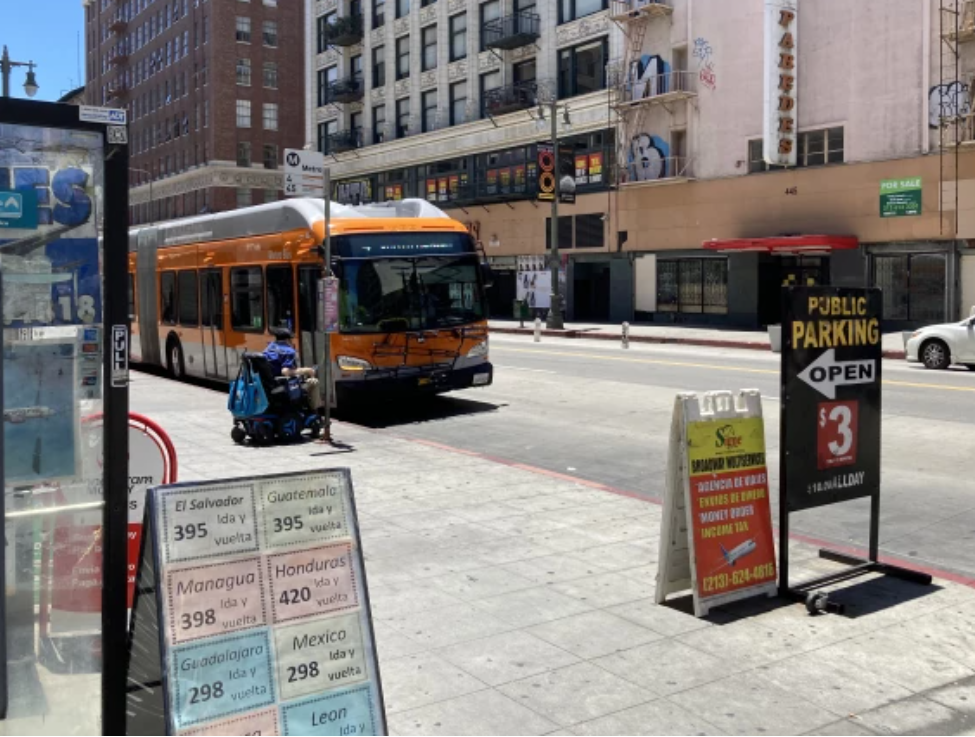

Heat waves and high temperatures are here to stay, but only about 25% of L.A.’s bus stops provide shelter, leaving one of the city’s most vulnerable populations — bus riders — without shade.
A 20-year contract meant to install up to 1,285 bus shelters and bring $150 million in revenue to the City of Los Angeles came up short at the end of 2021 — yielding about half the projected number of shelters and just 52% of the projected dollars.
To address the shortfall, StreetsLA (a division of the Department of Public Works formerly known as the Bureau of Street Services) has developed the Sidewalk and Transit Amenities Program (STAP).
In May, StreetsLA chose a new private partner for the program — Tranzito-Vector, a joint venture between curb manager and mobility hub startup Tranzito and transit advertising company Vector Media, ousting 20-year incumbent Outfront/JCDecaux.
But as the contract moves to city council for a vote, groups opposed to public advertising — notably the nonprofit advocacy organization Scenic Los Angeles (formerly The Coalition to Ban Billboard Blight) — are crying foul over digital advertising in the public right of way. Meanwhile, city employees and community advocates say that opponents to the new contract are a vocal and affluent minority who don’t ride the bus.
Why L.A. has so few bus shelters
Bus shelters are an issue of climate justice for the city’s most vulnerable residents, including the elderly, people with disabilities and children. L.A. Metro bus riders have a median income of only $17,975 and are predominantly Black, Indigenous, Latinx, Asian and Pacific Islander.
But although transit shelters are a key piece of city infrastructure, L.A. does not pay to install or maintain them. Instead, it makes money by placing ads on third party bus shelters and kiosks around the city.
Thus, prior to 2002, bus shelters were placed in neighborhoods that would draw the most advertising revenue — not the neighborhoods with the most transit ridership, according to a 2001 study by researchers at UCLA.
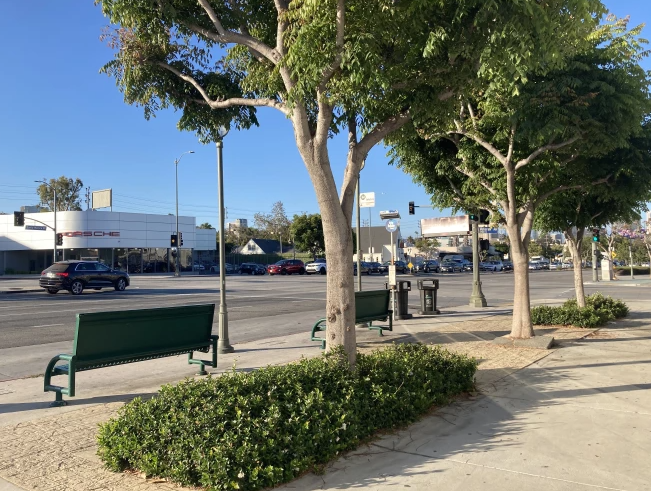
In 2001, Los Angeles signed a 20-year street furniture contract with Paris-based JCDecaux that was meant to address these inequities by giving the city more power to determine where bus shelters were placed. In exchange for the exclusive right to advertise in the public right of way through an outdoor media partner (currently Outfront), JCDecaux would install and maintain bus shelters and give the city a percentage of ad revenue.
However, the agreement failed to deliver. According to JCDecaux, only about 660 new bus shelters were installed. There are currently about 8,200 bus stops and 1,870 bus shelters total, leaving over 75% of bus stops without dedicated shade.
According to Francois Nion, co-managing director for Outfront/JCDecaux in Los Angeles, the existing program broke down because of an arduous permit approval process and public backlash over advertising.
To be approved, each shelter has to go through a 16-step process involving eight different city agencies, including the LAPD, LADWP and LADOT. Each city council district also has to sign off on the permit.
“We had sites [that] have been in limbo for 1,000 days, 2,000 days, but nobody wants to approve it [and] nobody wants to deny it.”
Local constituents opposed to advertising in their neighborhoods successfully lobbied their city council members to keep ads — and therefore bus shelters — out of their communities.
“The way the current contract was written, it really was about the advertising revenue, not about the actual shelter,” said Move L.A. executive director Eli Lipmen. “So you ended up with this fight over advertising rather than what this really should be about, which is protecting people from extreme heat.”
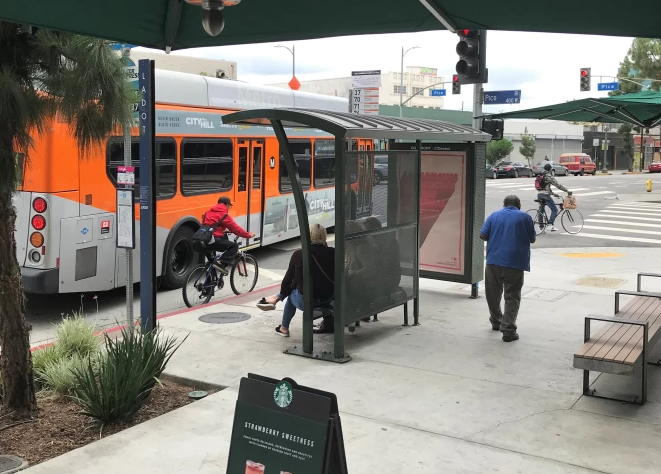
The City Council has been trying to renegotiate the contract with JCDecaux since 2003 to streamline the approval process and reap more of the promised ad revenue, according to reporting from KPCC. Despite these attempts and a highly critical audit by city controller Wendy Greuel in 2012, the 16-step process has remained intact.
In 2019, the city council voted not to extend the 20-year contract with JCDecaux and instead to launch a request for proposal (RFP) process to open up the street furniture contract to other bidders. In December 2021, they voted to extend the contract for one year to finish the process.
How is the new contract different?
With the new contract, StreetsLA — a city agency in charge of street trees, sidewalk repairs, pavement preservation and other services — aims to serve 75% of bus riders in each council district by building 3,000 bus shelters and an additional 450 shade structures in 10 years.
Tranzito-Vector may also install new smart city features as part of the deal, including e-paper digital displays, Wi-Fi, phone charging, e-commerce lockers and scooter docks.
The city is covering capital expenses for the program, meaning that it will own the new street furniture outright and receive a greater share of advertising revenues from bus shelter ads, 60.5% versus the 20% it currently receives from JCDecaux.
Over the 10-year contract, Tranzito-Vector is guaranteeing the city a minimum of $90 million with current projections putting expected revenue at $350 to $400 million.
Lance Oishi, contract administrator and street furniture program manager for StreetsLA, said that the new contract will also bypass the bureaucratic permitting process of the past by requiring only two approvals.
But it’s the added provision allowing digital ads — which generate more money than static ads — that has sparked the most controversy.
Why the fight over digital advertising?
Scenic Los Angeles is rallying neighborhood groups against the new STAP contract, hoping to prevent the proliferation of digital ads on L.A.’s streets and sidewalks. But according to Oishi, less than 700 — or less than 25% — of the new shelters will have digital ads.
“We really feel besieged,” said Barbara Broide, board member of Scenic Los Angeles. “It’s not just STAP. STAP is designed to open the door for other public right of way advertising, unlimited advertising, undefined advertising.”
According to Oishi, the City Council asked StreetsLA to draft changes to the L.A. municipal code as part of STAP that would allow additional advertising structures in the public right of way.
Currently, only JCDecaux is allowed to place advertising on bus shelters and kiosks. However, other city agencies have expressed interest in placing public advertising, including Metro Bike Share and the Los Angeles Tourism & Convention Board.
The changes would give the Department of Public Works the power to approve new advertising programs.
However, Oishi called concerns about unlimited public advertising “overblown and exaggerated,” saying that the city doesn’t want a proliferation of digital ads because oversaturation would drive down revenue.
Oishi noted that any new advertising program would have to go through a California Environmental Quality Act (CEQA) process to determine the environmental impacts and be approved by city council.
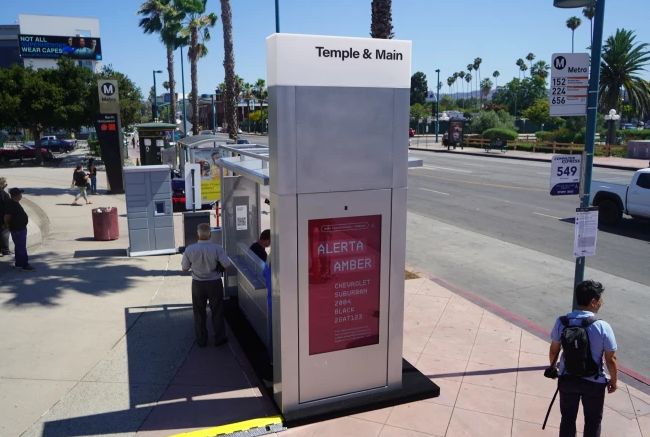
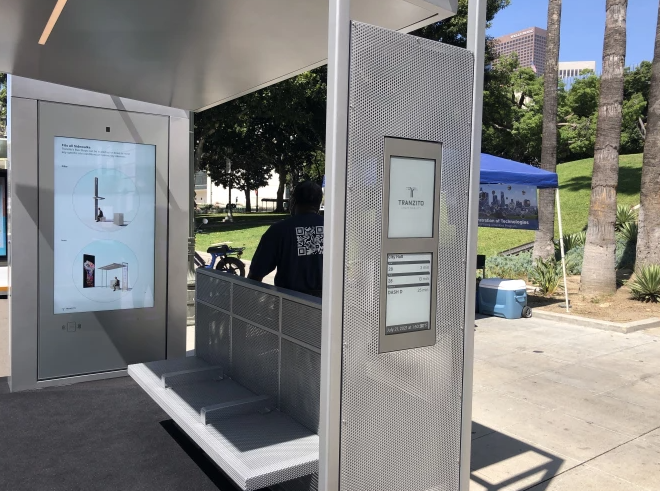
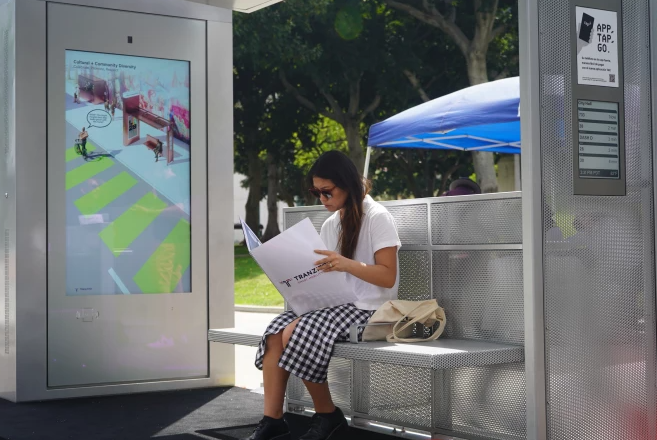
Backlash over public advertising in Los Angeles goes back decades. Scenic Los Angeles has been fighting the billboard and outdoor advertising industry — with a particular focus on blocking digital billboards — since 1986. In a Los Angeles Times article from 2005, local activists referred to bus shelter ads as “sidewalk billboards” while vocalizing their opposition to a new policy designed to speed up the permit approval process for installing new bus shelters.
However, Oishi said that opponents of digital advertising are equating the media panels on transit shelters to digital billboards to spark “animosity and paranoia and fear.” The average media panel for transit shelters will be 6×4 square feet, while the average billboard is 48×14 feet.
Scenic Los Angeles claims that, among other issues, even smaller-sized digital ads on bus shelters will distract drivers, putting pedestrians and cyclists at risk. However, the primary mission of Scenic Los Angeles is not pedestrian and cyclist advocacy but to “preserve and enhance the visual character and scenic beauty of America.”
“We have a city that is densifying…” said Broide. “We are building taller, we are building denser, there’s less and less open space for people to plant trees to enjoy.”
She continued, “Instead, it sounds like we’re planting billboards and digital signs. It’s wrong.”
A case study: Santa Monica Boulevard
In 2006, Los Angeles finished an ambitious reconstruction of Santa Monica Boulevard in Westwood and Century City that took three years (a year longer than expected) and ran over budget by over $20 million.
Not included in the $90 million price tag: money to install and maintain bus shelters along the 2.2-mile stretch from Sepulveda Boulevard to Beverly Hills.
Matthew Hetz, a musician, composer and instructor at Emeritus/Santa Monica College, fought for years to get bus shelters installed along that corridor. But he said that although he “pleaded” with neighborhood groups in Council District 5 to allow bus shelters with ads, they refused.
“These are people who have very comfortable lives,” he said. “And I would say, ‘The people who ride the buses, a lot of them are not wealthy, they’re poor. And so by denying the bus stops along Santa Monica Boulevard, you’re creating hardships for people of lesser means.’”
Nion — who at the time was on the Westside Neighborhood Council representing Century City (which that stretch of Santa Monica Boulevard runs through) — confirmed Hetz’s version of the events at the time.
“For us, it was like, ‘Oh my God, it’s a big boulevard, it’s on the west side, it’s brand new, sidewalks are so wide, there is no ADA [Americans with Disabilities Act] issue — all the objective criteria are met,” he said.
Oishi, who was the chief landscape architect on the project for the city of L.A., said that people came out “in droves” to oppose advertising on Santa Monica Boulevard.
“That’s the democratic process at work,” he added. “[That’s] what the constituency wanted for those communities, and we accommodated that. But that doesn’t account for, again, the people that are actually riding the bus.”
Missing from this democratic process were the voices of the transit riders themselves, Nion explained. “You’ve got 25,000 cars on that block every day — 25,000 cars — so what’s really wrong with a little, tiny bus shelter?”
Broide says that she’s not against the bus shelters themselves — only the ads.
“There could be transit shelters up and down Santa Monica Boulevard without ads. And there should be,” she said.
But 16 years after the reconstruction of Santa Monica Boulevard was completed from the 405 to Beverly Hills, there are wide sidewalks, tree-dotted medians, six lanes of traffic, a bike lane — and zero bus shelters.
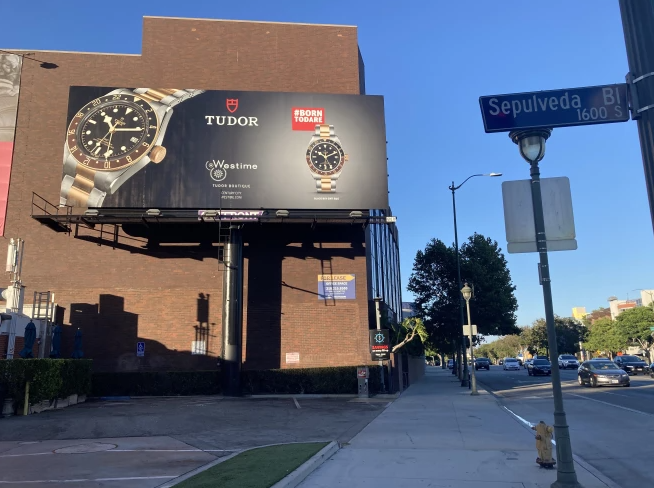
And while local constituents were able to prevent bus shelters with ads from being built along the Boulevard, they were not able to prevent all advertising. There are multiple billboards visible from the road, most of them owned by Outfront, the same company that places ads on bus shelters.
Currently, a billboard for luxury watches towers over the bus stop at the southeast corner of Santa Monica and Sepulveda. The cheapest watch advertised is $4,300.
Who gets to use public space?
The absence of transit amenities like bus shelters is an example of “hostile design,” according to urban planning doctoral candidate Chris Giamarino.
“‘It’s called ‘soft control’…it’s like, “Alright, we provide a bus stop with a sign,’ but there’s no shade or bench. So no one’s gonna hang out there.”
Hostile design is used to keep marginalized groups from using public infrastructure — another example would be placing armrests or bars on public benches to prevent people from lying down.
To some advocates, the fight over digital advertising on bus shelters is a proxy fight over unhoused Angelenos and their access to public space.
“[There’s] a lot of nimbyism,” said Cynde Soto, a disability rights advocate who works in transit justice. “They don’t want [bus shelters] in their backyard because they think unhoused people will set up camp there.”
Whatever the case, the battle over digital advertising has “sucked up all the oxygen in the room,” noted Tom Grode, co-chair of the transit justice working group for the Skid Row Community Improvement Coalition.
“It’s an equity issue, not only in terms of neighborhoods, but…in terms of who’s actually even using the buses,” he said. “So that needs to be front and center, in front of the mayor’s office, in front of all the city council members — they all need to recognize that there’s a very serious transit justice issue.”
What happens next?
An Initial Study and Mitigated Negative Declaration for the Sidewalk and Transit Amenities Program was completed in February 2022.
To be approved, the proposed contract needs to go through the public works committee and the budget and finance committee and then to the Council for a vote.
If a full Environmental Impact Review (EIR) is not conducted, and the contract moves forward, any person or organization can file a lawsuit in objection.
According to Oishi, Both JCDecaux and Scenic Los Angeles are pursuing legal options to stop the contract. (In a statement to KCET, Nion said, “We trust the process”).
Concerned citizens for or against the new contract can submit public comments to the council file.

